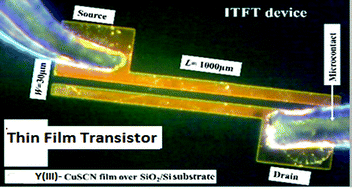Yttrium-doped CuSCN thin film transistor: synthesis and optoelectronic characterization study†
Abstract
Highly efficient, solution-processable, transparent semiconductor thin films of yttrium-doped copper thiocyanate (Y(III)-CuSCN) have been developed using a simple and cost-effective modified spin coating method and investigated for their optical, electrical and electrochemical properties. The pure β-CuSCN pinhole-free compact thin films (40 nm thickness) showed ∼242 S cm−1 electrical conductivity with 0.97 root mean square surface roughness (Rrms) and an indirect bandgap of 3.72 eV. The 1 mole% Y(III)-CuSCN (65 nm thick) afforded an Rrms of 3.2 nm, with a narrowed bandgap of 3.46 eV and remarkably improved electrical conductivity of ∼566 S cm−1. Impedance studies indicated a flat-band potential of −5.19 eV and 65.3k Ω cm−2 as the interfacial charge transfer resistance for pure CuSCN. The values for the 1 mole% Y(III)-CuSCN were 14.13k Ω cm−2 for interfacial charge transport through the grains and 23.73k Ω cm−2via the grain boundaries. The hole mobility values for thin film transistor (TFT) devices were the highest among those reported for CuSCN; they were recorded as ∼0.36 cm2 V−1 s−1 and ∼0.99 cm2 V−1 s−1 for the pure and Y-doped CuSCN materials, respectively, and the on/off ratio was ∼104.



 Please wait while we load your content...
Please wait while we load your content...